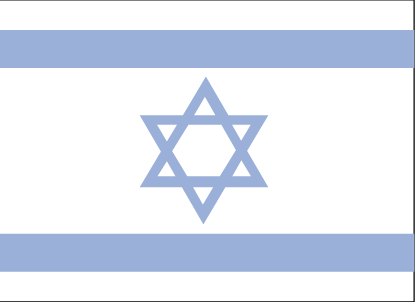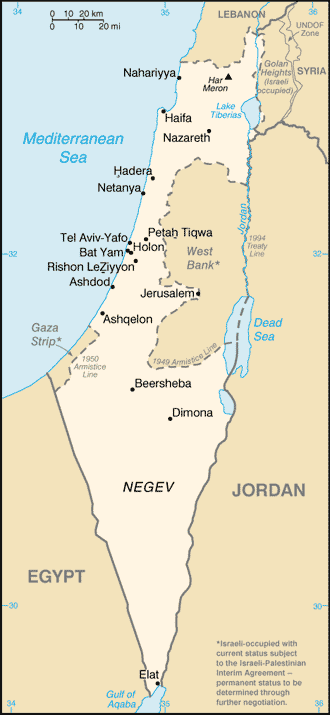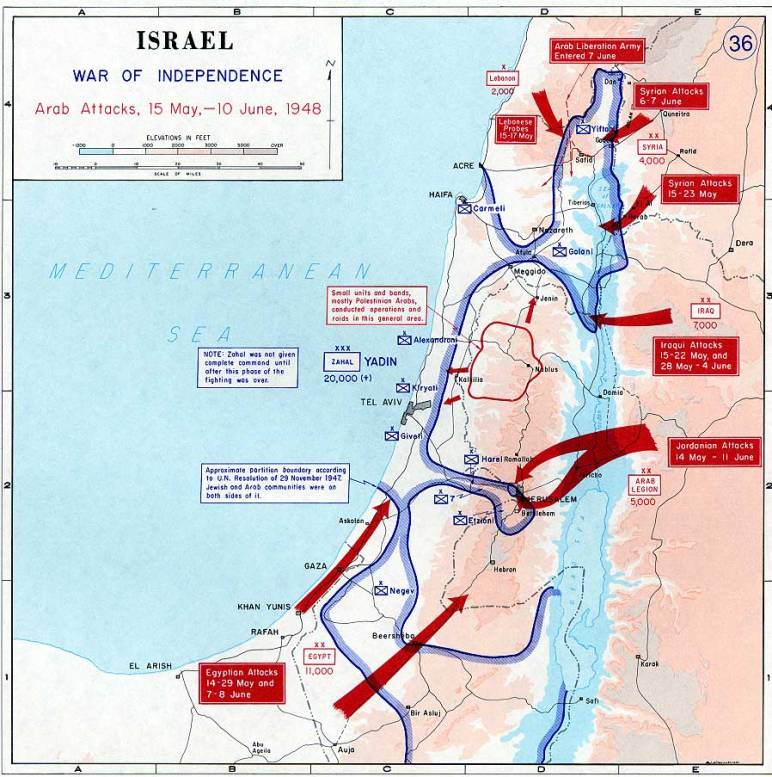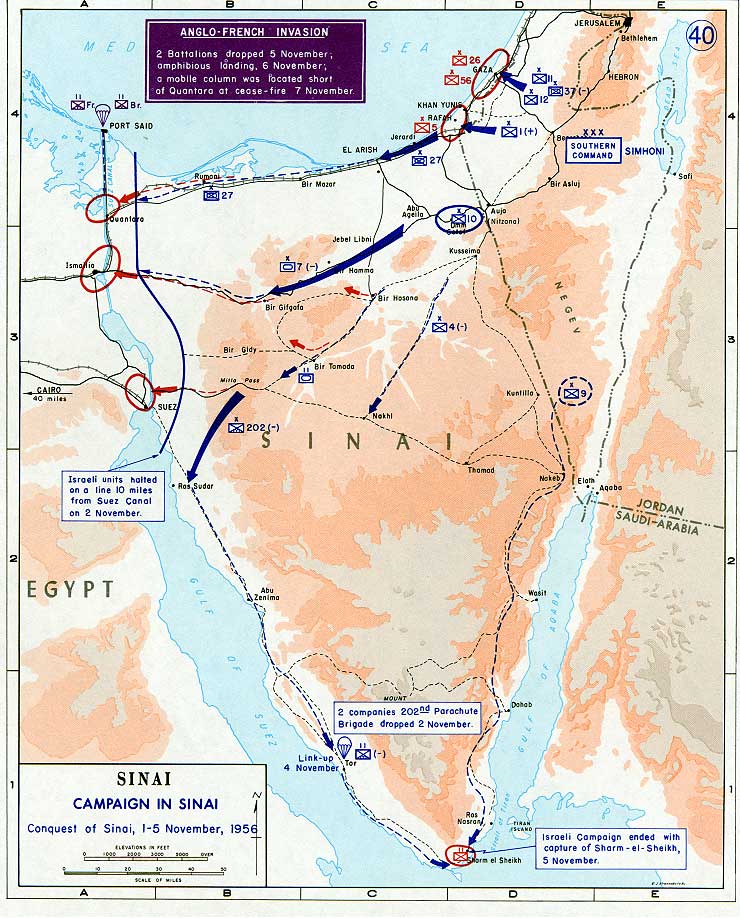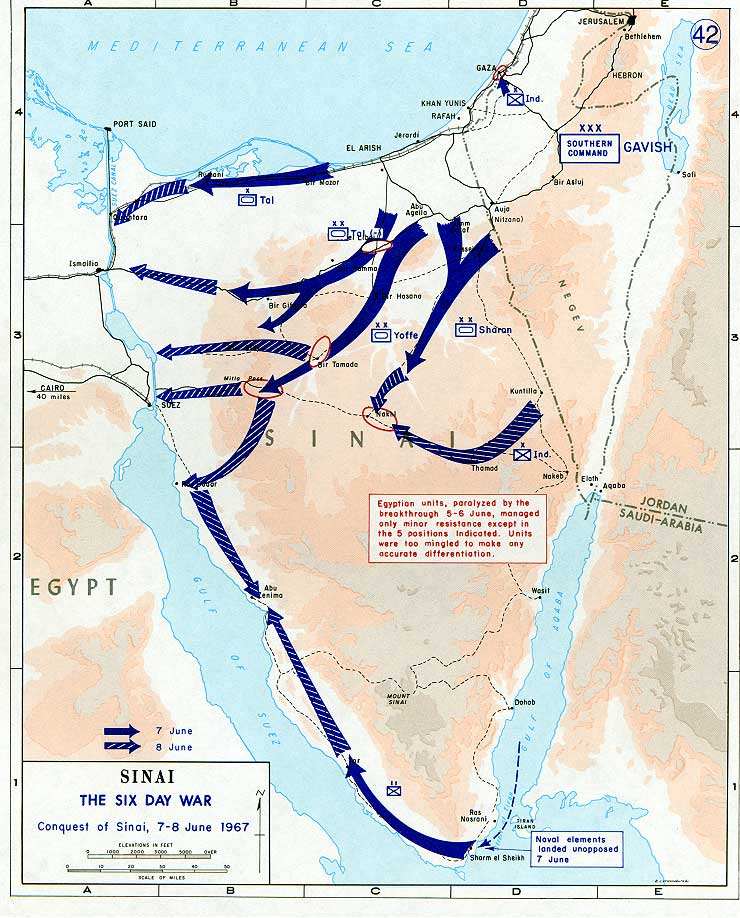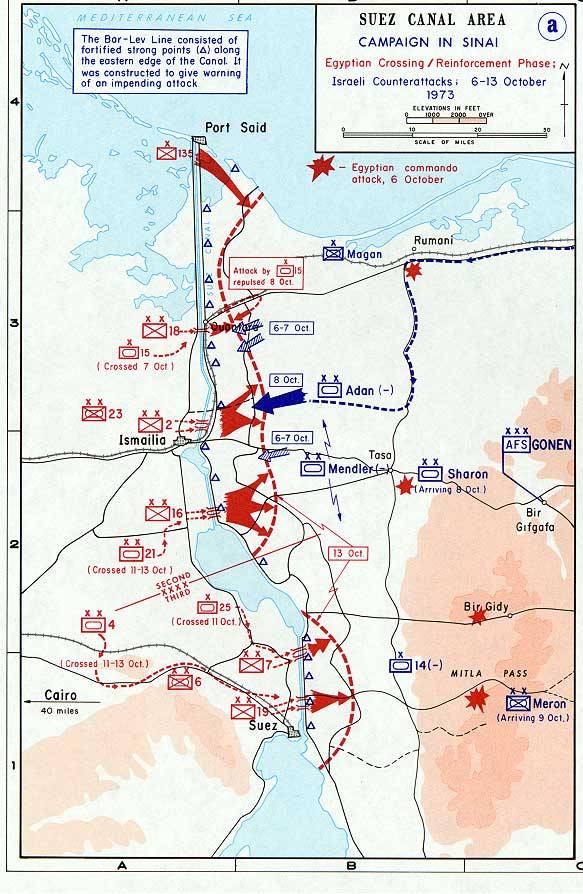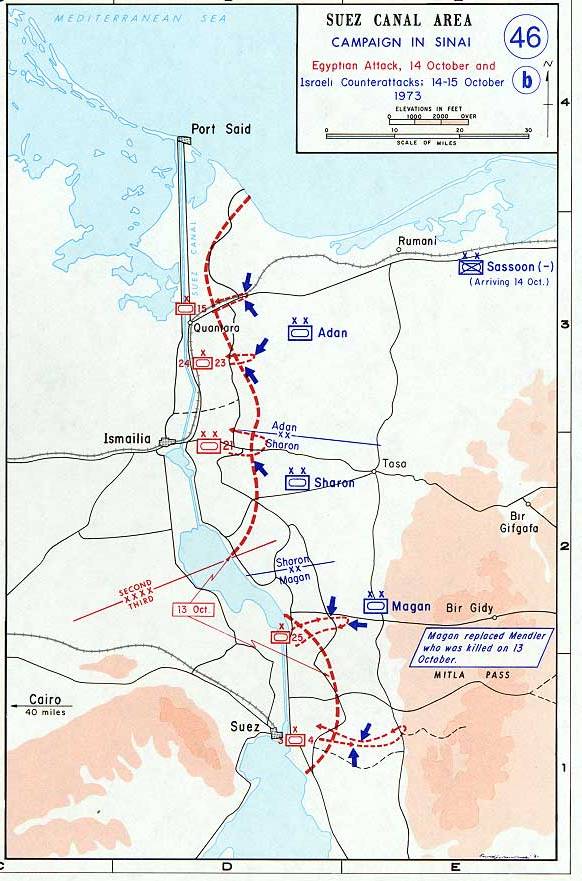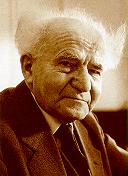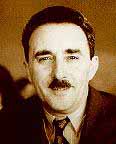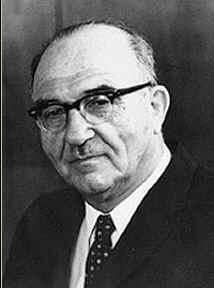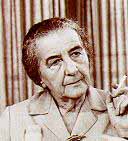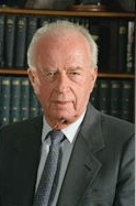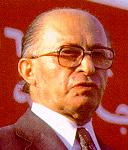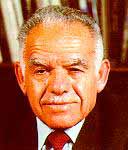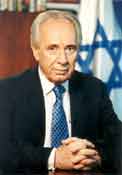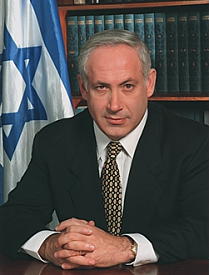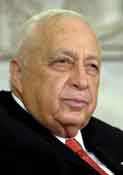State of Israel
Flag Description: white with a blue hexagram (six-pointed linear star) known as the Magen David (Shield of David) centered between two equal horizontal blue bands near the top and bottom edges of the flag
Israel Timeline
| 17th-6th C. BCE | BIBLICAL TIMES
|
| (BCE - Before the Common Era) |
c.17th century

Drawings by
Noam Nadav | Abraham, Isaac, Jacob - patriarchs of the Jewish people and bearers of a belief in one God - settle in the Land of Israel.
Famine forces Israelites to migrate to Egypt. |
| c.13th century | Exodus from Egypt: Moses leads Israelites from Egypt, followed by 40 years of wandering in the desert.
Torah, including the Ten Commandments, received at Mount Sinai. |
13th-12th
centuries | Israelites settle in the Land of Israel |
| c.1020 | Jewish monarchy established; Saul, first king. |
| c.1000 | Jerusalem made capital of David's kingdom. |
| c.960 | First Temple, the national and spiritual center of the Jewish people, built in Jerusalem by King Solomon. |
| c. 930 | Divided kingdom: Judah and Israel |
| 722-720 | Israel crushed by Assyrians; 10 tribes exiled (Ten Lost Tribes). |
| 586 | Judah conquered by Babylonia; Jerusalem and First Temple destroyed; most Jews exiled. |
THE SECOND TEMPLE PERIOD |
| 538-142 | Persian and Hellenistic periods |
| 538-515 | Many Jews return from Babylonia; Temple rebuilt. |
| 332 | Land conquered by Alexander the Great; Hellenistic rule. |
166-160

| Maccabean (Hasmonean) revolt against restrictions on practice of Judaism and desecration of the Temple |
| 142-129 | Jewish autonomy under Hasmoneans. |
| 129-63 | Jewish independence under Hasmonean monarchy. |
| 63 | Jerusalem captured by Roman general, Pompey. |
|
63 BCE-313
CE | Roman rule |
63-4 BCE

| Herod, Roman vassal king, rules the Land of Israel;
Temple in Jerusalem refurbished |
(CE - The Common Era) |
| c. 20-33 | Ministry of Jesus of Nazareth |
| 66 | Jewish revolt against the Romans |
| 70 | Destruction of Jerusalem and Second Temple. |
| 73 | Last stand of Jews at Masada. |
| 132-135 | Bar Kokhba uprising against Rome. |
| c. 210 | Codification of Jewish oral law (Mishna) completed. |
|
| FOREIGN DOMINATION |
| 313-636 | Byzantine rule |
| c. 390 | Commentary on the Mishna (Jerusalem Talmud) completed. |
| 614 | Persian invasion |
|
| 636-1099 | Arab rule |
| 691 | On site of First and Second Temples in Jerusalem, Dome of the Rock built by Caliph Abd el-Malik. |
|
| 1099-1291 | Crusader domination
(Latin Kingdom of Jerusalem) |
|
| 1291-1516 | Mamluk rule |
|
| 1517-1917 | Ottoman rule |
| 1564 | Code of Jewish law (Shulhan Arukh) published. |
| 1860 | First neighborhood built outside walls of Jerusalem's Old City. |
| 1882-1903 | First Aliya (large-scale immigration), mainly from Russia. |
1897

| First Zionist Congress convened by Theodor Herzl in Basel, Switzerland; Zionist Organization founded. |
| 1904-14 | Second Aliya, mainly from Russia and Poland. |
| 1909 | First kibbutz, Degania, and first modern all-Jewish city, Tel Aviv, founded. |
| 1917 | 400 years of Ottoman rule ended by British conquest; British Foreign Minister Balfour pledges support for establishment of a "Jewish national home in Palestine" |
|
| 1918-48 | British rule |
| 1919-23 | Third Aliya, mainly from Russia |
| 1920 | Histadrut (General Federation of Labor) and Haganah (Jewish defense organization) founded.
Vaad Leumi (National Council) set up by Jewish community (Yishuv) to conduct its affairs. |
| 1921 | First moshav (cooperative village), Nahalal, founded. |
| 1922 | Britain granted Mandate for Palestine (Land of Israel) by League of Nations; Transjordan set up on three-fourths of the area, leaving one fourth for the Jewish national home.
Jewish Agency representing Jewish community vis-a-vis Mandate authorities set up. |
1924

| Technion, first institute of technology, founded in Haifa. |
| 1924-32 | Fourth Aliya, mainly from Poland. |
| 1925 | Hebrew University of Jerusalem opened on Mount Scopus. |
| 1929 | Hebron Jews massacred by Arab terrorists. |
| 1931 | Etzel, Jewish underground organization, founded. |
| 1933-39 | Fifth Aliya, mainly from Germany. |
| 1936-39 | Anti-Jewish riots instigated by Arab terrorists. |
| 1939 | Jewish immigration severely limited by British White Paper. |
| 1939-45 | World War II; Holocaust in Europe. |
| 1941 | Lehi underground movement formed; Palmach, strike force of Haganah, set up. |
| 1944 | Jewish Brigade formed as part of British forces. |
| 1947 | UN proposes the establishment of Arab and Jewish statesin the Land. |
|
STATE OF ISRAEL
|
1948

| End of British Mandate (14 May)
State of Israel proclaimed (14 May).
Israel invaded by five Arab states (15 May).
Israel Defense Forces (IDF) established.
War of Independence (May 1948-July 1949). |
| 1949 | Armistice agreements signed with Egypt, Jordan, Syria, Lebanon.
Jerusalem divided under Israeli and Jordanian rule.
First Knesset (parliament) elected.
Israel admitted to United Nations as 59th member. |
1948-52

| Mass immigration from Europe and Arab countries. |
| 1956 | Sinai Campaign |
| 1962 | Adolf Eichmann tried and executed in Israel for his part in the Holocaust. |
1964

| National Water Carrier completed, bringing water from Lake Kinneret in the north to the semi-arid south. |
1967

| Six-Day War; Jerusalem reunited. |
| 1968-70 | Egypt's War of Attrition against Israel |
| 1973 | Yom Kippur War |
| 1975 | Israel becomes an associate member of the European Common Market. |
| 1977 | Likud forms government after Knesset elections, end of 30 years of Labor rule.
Visit of Egyptian President Anwar Sadat to Jerusalem. |
| 1978 | Camp David Accords include framework for comprehensive peace in the Middle East and proposal for Palestinian self-government. |
| 1979 | Israel-Egypt Peace Treatysigned.
Prime Minister Menachem Begin and President Anwar Sadat awarded Nobel Peace Prize. |
| 1981 | Israel Air Force destroys Iraqi nuclear reactor just before it is to become operative. |
| 1982 | Israel's three-stage withdrawal from Sinai Peninsula completed.
Operation Peace for Galilee removes Palestine Liberation Organization (PLO) terrorists from Lebanon. |
| 1984 | National unity government (Likud and Labor) formed after elections.
Operation Moses, immigration of Jews from Ethiopia. |
| 1985 | Free Trade Agreement signed with United States. |
| 1987 | Widespread violence (Intifada) starts in Israeli-administered areas. |
| 1988 | Likud government wins elections. |
1989

| Four-point peace initiative proposed by Israel.
Start of mass immigration of Jews from former Soviet Union. |
| 1991 | Israel attacked by Iraqi Scud missiles during Gulf war.
Middle East peace conference convened in Madrid; Operation Solomon, airlift of Jews from Ethiopia. |
| 1992 | Diplomatic relations established with China and India.
New government headed by Yitzhak Rabin of Labor Party. |
| 1993 | Declaration of Principleson Interim Self-Government Arrangements for the Palestinians signed by Israel and PLO, as representative of the Palestinian people (Oslo Accords). |
1994
 | Implementation of Palestinian self-government inGaza Strip and Jericho area. Full diplomatic relations with the Holy See. Morocco and Tunisia interest offices set up. Israel-Jordan Peace Treaty signed. Rabin, Peres, Arafat awarded Nobel Peace Prize. |
| 1995 | Broadened Palestinian self-government implemented in West Bank and Gaza Strip; Palestinian Council elected. Prime Minister Rabin assassinated at peace rally. Shimon Peres becomes prime minister. |
| 1996 | .Fundamentalist Arab terrorism against Israel escalates. Operation Grapes of Wrath, retaliation for Hizbullah terrorists' attacks on northern Israel. Trade representation offices set up in Oman and Qatar. Likud forms government after Knesset elections. Binyamin Netanyahu elected prime minister. Omani trade representation office opened in Tel Aviv |
| 1997 | .Hebron Protocol signed by Israel and the PA |
1998
 | Israel celebrates its 50th anniversary. Israel and the PLO sign the Wye River Memorandum to facilitate implementation of the Interim Agreement. |
| 1999 | Ehud Barak (left-wing One Israel party) elected prime minister; forms coalition government. Israel and the PLO sign the Sharm-el-Sheikh Memorandum. |
| 2000 | Visit of Pope Paul II. Israel withdraws from the Security Zone in southern Lebanon. Israel admitted to UN Western European and Others Group. Renewed violence (Second Intifada). Prime Minister Barak resigns. |
| 2001 | Ariel Sharon (Likud) elected Prime Minister; forms broad-based unity government. The Sharm-el-Sheikh Fact-Finding Committee report (Mitchell Report) issued. Palestinian-Israeli Security Implementation Work Plan (Tenet ceasefire plan) proposed. Rechavam Ze'evy, Minister of Tourism, assassinated by Palestinian terrorists. |
| 2002 | Israel launches Operation Defensive Shield in response to massive Palestinian terrorist attacks. Israel begins building the anti-terrorist fence to stop West Bank terrorists from killing Israeli citizens. Prime Minister Sharon disperses the Knesset, calling for new elections to be held on 28 January 2003. |
| 2003 | Right-of-center coalition government formed by Prime Minister Ariel Sharon. Israel accepts the Roadmap. |
| 2005 | Israel carries out the Disengagement Plan, ending Israel's presence in the Gaza Strip. |
| 2006 | After Prime Minister Sharon suffers a stroke, Ehud Olmert becomes acting prime minister. Following elections on 28 March, Prime Minister Ehud Olmert forms new government led by the Kadima Party. Israel carried out military operations against Palestinian terrorists in Gaza after kidnapping of Israeli soldier. The Second War in Lebanon, during which Israel carried out military operations against Hizbullah terrorism from southern Lebanon, following missile attacks and kidnapping of two Israeli soldiers. |
| 2007 | Shimon Peres elected President by the Knesset. Israel declares Gaza "hostile territory" following Hamas violent takeover of Gaza Strip. |
| 2008 | Israel celebrates its 60th anniversary. Israel launches its Gaza Operation (Operation Cast Lead) in response to the barrage of over 10,000 rockets and mortars fired from the Gaza Strip. |
| 2009 | Benjamin Netanyahu is elected Prime Minister in national elections held in February 2009, and forms a broad-based coalition government The city of Tel Aviv celebrates its 100th anniversary. |
| 2010 | Israel joins the Organization for Economic Co-operation and Development (OECD). |
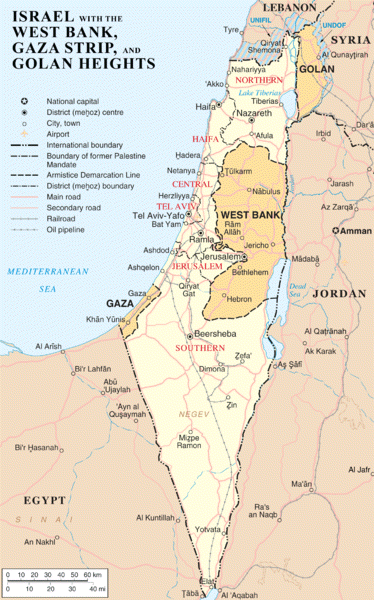
Following World War II, the British withdrew from their mandate of Palestine.
On 29 November 1947 the United Nations Partition Plan for Palestine or United Nations General Assembly Resolution 181, a plan to resolve the Arab-Israeli conflict in the British Mandate of Palestine, was approved by the United Nations General Assembly, at the UN World Headquarters in New York.
The UN partitioned the area into Arab and Jewish states, an arrangement rejected by the Arabs. Subsequently, the Israelis defeated the Arabs in a series of wars without ending the deep tensions between the two sides.
1948 War of Independence-The 1948 Arab-Israeli War, referred to as the "War of Independence or as the "War of Liberation by Israelis, is the first in a series of armed conflicts fought between Israel and its Arab neighbors in the ongoing Arab-Israeli conflict.
Department of History, U.S. Military Academy
After the United Nations proposed to partition the territory of the British Mandate of Palestine into two states, Jewish and Arab, the Arabs refused to accept it and the armies of Egypt, Syria, Transjordan, Lebanon and Iraq, supported by others, attacked the newly established State of Israel which they refused to recognize. As a result, the region was divided between Israel, Egypt and Transjordan.
1956 Sinai War-The Suez Crisis was a war fought on Egyptian territory in 1956. The conflict pitted Egypt against Israel, the United Kingdom and the Fourth French Republic.Eventually, pressure from the United States forced Britain, France, and Israel to withdraw.
Department of History, U.S. Military Academy
1967 Six Day War-The Six-Day War was fought between Israel and the Arab states of Egypt, Jordan, Iraq, and Syria. When Egypt expelled the United Nations Emergency Force from the Sinai Peninsula, increased its military activity near the border, and blockaded the Straits of Tiran to Israeli ships, Israel launched a pre-emptive attack on Egypt's air force fearing an imminent attack by Egypt. Jordan in turn attacked the Israeli cities of Jerusalem and Netanya. At the war's end, Israel had gained control of the Gaza Strip, the Sinai Peninsula, the West Bank, and the Golan Heights.
1973 Yom Kippur War-The Yom Kippur War was fought from October 6 to October 26, 1973, between Israel and a coalition of Arab nations led by Egypt and Syria. The war began on the Jewish holiday of Yom Kippur with a surprise joint attack by Egypt and Syria crossing the cease-fire lines in the Sinai and Golan Heights, respectively, which had been captured by Israel in 1967 during the Six-Day War.The Egyptians and Syrians advanced during the first 24–48 hours, after which momentum began to swing in Israel's favor. By the second week of the war, the Syrians had been pushed entirely out of the Golan Heights. In the Sinai to the south, the Israelis had struck at the "seam" between two invading Egyptian armies, crossed the Suez Canal (where the old ceasefire line had been), and cut off an entire Egyptian army just as a United Nations cease-fire came into effect.
On 25 April 1982, Israel withdrew from the Sinai pursuant to the 1979 Israel-Egypt Peace Treaty.
Israel and Palestinian officials signed on 13 September 1993 a Declaration of Principles (also known as the "Oslo Accords") guiding an interim period of Palestinian self-rule. Outstanding territorial and other disputes with Jordan were resolved in the 26 October 1994 Israel-Jordan Treaty of Peace. In addition, on 25 May 2000, Israel withdrew unilaterally from southern Lebanon, which it had occupied since 1982. In keeping with the framework established at the Madrid Conference in October 1991, bilateral negotiations were conducted between Israel and Palestinian representatives and Syria to achieve a permanent settlement.
In April 2003, US President Bush, working in conjunction with the EU, UN, and Russia - the "Quartet" - took the lead in laying out a roadmap to a final settlement of the conflict by 2005, based on reciprocal steps by the two parties leading to two states, Israel and a democratic Palestine. However, progress toward a permanent status agreement was undermined by Palestinian-Israeli violence between September 2000 and February 2005. An agreement reached at Sharm al-Sheikh in February 2005 significantly reduced the violence.
In the summer of 2005, Israel unilaterally disengaged from the Gaza Strip, evacuating settlers and its military while retaining control over most points of entry into the Gaza Strip. The election of HAMAS in January 2006 to head the Palestinian Legislative Council froze relations between Israel and the Palestinian Authority (PA). Ehud OLMERT became prime minister in March 2006; he shelved plans to unilaterally evacuate from most of the West Bank following an Israeli military operation in Gaza in June-July 2006 and a 34-day conflict with Hizballah in Lebanon in June-August 2006. OLMERT in June 2007 resumed talks with the PA after HAMAS seized control of the Gaza Strip and PA President Mahmoud ABBAS formed a new government without HAMAS. OLMERT in September 2008 resigned in the wake of several corruption allegations, but remained prime minister until the new coalition government under former Prime Minister Binyamin NETANYAHU was completed in late March 2009, following the February general election.
Geography
Area: 20,330 sq. km.1 (7,850 sq. mi.); about the size of New Jersey.
Cities: Capital--Jerusalem.2 Other cities--Tel Aviv, Haifa.
Terrain: Plains, mountains, desert, and coast.
Climate: Temperate, except in desert areas.
People
Population (2009 est.): 7.23 million.
Annual population growth rate (2009 est.): 1.7%.
Ethnic groups: Jews 76.2%; Arabs 19.5%; other 4.3%.
Religions: Judaism, Islam, Christianity, Druze.
Languages: Hebrew (official), Arabic (official), English, Russian.
Education: Years compulsory--11. Literacy--96.9% (female 95.6%; male 98.3%).
Health: Infant mortality rate (2009 est.)--4.22/1,000 births. Life expectancy at birth--80.73 years; female 82.95 years, male 78.62 years.
Work force (2.68 million; Central Bureau for Statistics, 2004): Agriculture--2.1%; manufacturing--16.2%; electricity and water supply--0.8%; construction--5.4%; trade and repair of motor vehicles--3.6%; accommodation services and restaurants--4.3%; transport, storage, and communication--6.5%; banking, insurance, and finance--3.3%; business activities--13.4%; public administration--4.7%; education--12.7%; health, welfare, and social services--10.7%; community, social, and personal services--4.6%; services for households by domestic personnel--1.6%.
Government
Type: Parliamentary democracy.
Independence: May 14, 1948.
Constitution: None; however, the Declaration of Establishment (1948), the Basic Laws of the parliament (the Knesset), and the Israeli citizenship law fill many of the functions of a constitution.
Branches: Executive--president (chief of state); prime minister (head of government). Legislative--unicameral Knesset. Judicial--Supreme Court.
Political parties: Labor, Likud, Kadima, and various other secular and religious parties, including some wholly or predominantly supported by Israel's Arab citizens. A total of 12 parties are represented in the 18th Knesset, elected February 2009.
Suffrage: Universal at 18.
Economy
GDP (2008 est.): $203.4 billion.
Annual growth rate (2008): 4.2%.
Per capita GDP (2008): $28,600.
Currency: Shekel (3.82shekels = 1 U.S. dollar; 2009 est.).
Natural resources: Copper, phosphate, bromide, potash, clay, sand, sulfur, bitumen, manganese.
Agriculture: Products--citrus and other fruits, vegetables, beef, dairy, and poultry products.
Industry: Types--high-technology projects (including aviation, communications, computer-aided design and manufactures, medical electronics, fiber optics), wood and paper products, potash and phosphates, food, beverages, tobacco, caustic soda, cement, construction, plastics, chemical products, diamond cutting and polishing, metal products, textiles, and footwear.
Trade: Exports (2008 est.)--$57.16 billion. Exports include polished diamonds, electronic communication, medical and scientific equipment, chemicals and chemical products, electronic components and computers, machinery and equipment, transport equipment, rubber, plastics, and textiles. Imports (excluding defense imports, 2008 est.)--$64.4 billion: raw materials, diamonds, energy ships and airplanes, machinery, equipment, land transportation equipment for investment, and consumer goods. Major partners--U.S., U.K., Germany; exports--U.S., Belgium, Hong Kong; imports--U.S., Belgium, Germany, Switzerland, U.K.
Including Jerusalem
Israel proclaimed Jerusalem as its capital in 1950. The United States, like nearly all other countries, maintains its embassy in Tel Aviv.
PEOPLE
Of the approximately 7.23 million Israelis in 2009, about 76% were counted as Jewish, though some of those are not considered Jewish under Orthodox Jewish law. Since 1989, nearly a million immigrants from the former Soviet Union have arrived in Israel, making this the largest wave of immigration since independence. In addition, an estimated 105,000 members of the Ethiopian Jewish community have immigrated to Israel, 14,000 of them during the dramatic May 1991 Operation Solomon airlift. 32.9% of Israelis were born outside of Israel.
The three broad Jewish groupings are the Ashkenazim, or Jews who trace their ancestry to western, central, and eastern Europe; the Sephardim, who trace their origin to Spain, Portugal, southern Europe, and North Africa; and Eastern or Oriental Jews, who descend from ancient communities in Islamic lands. Of the non-Jewish population, about 68% are Muslims, about 9% are Christian, and about 7% are Druze.
Education is compulsory from age 6 to 16 and is free up to age 18. The school system is organized into kindergartens, 6-year primary schools, 3-year junior secondary schools, and 3-year senior secondary schools, after which a comprehensive examination is offered for university admissions. There are seven university-level institutions in Israel, a number of regional colleges, and an Open University program.
With a population drawn from more than 100 countries on 5 continents, Israeli society is rich in cultural diversity and artistic creativity. The arts are actively encouraged and supported by the government. The Israeli Philharmonic Orchestra performs throughout the country and frequently tours abroad. The Jerusalem Symphony and the New Israel Opera also tour frequently, as do other musical ensembles. Almost every municipality has a chamber orchestra or ensemble, many boasting the talents of gifted performers from the countries of the former Soviet Union.
Israel has several professional ballet and modern dance companies, and folk dancing, which draws upon the cultural heritage of many immigrant groups, continues to be very popular. There is great public interest in the theater; the repertoire covers the entire range of classical and contemporary drama in translation as well as plays by Israeli authors. Of the three major repertory companies, the most famous, Habimah, was founded in 1917.
Active artist colonies thrive in Safed, Jaffa, and Ein Hod, and Israeli painters and sculptors exhibit works worldwide. Israel boasts more than 120 museums, including the Israel Museum in Jerusalem, which houses the Dead Sea Scrolls along with an extensive collection of regional archaeological artifacts, art, and Jewish religious and folk exhibits. Israelis are avid newspaper readers, with more than 90% of Israeli adults reading a newspaper at least once a week. Major daily papers are in Hebrew; others are in Arabic, English, French, Polish, Yiddish, Russian, Hungarian, and German.
HISTORY
The creation of the State of Israel in 1948 was preceded by more than 50 years of efforts to establish a sovereign state as a homeland for Jews. These efforts were initiated by Theodore Herzl, founder of the Zionist movement, and were given added impetus by the Balfour Declaration of 1917, which asserted the British Government's support for the creation of a Jewish homeland in Palestine.
In the years following World War I, Palestine became a British Mandate and Jewish immigration steadily increased, as did violence between Palestine's Jewish and Arab communities. Mounting British efforts to restrict this immigration were countered by international support for Jewish national aspirations following the near-extermination of European Jewry by the Nazis during World War II. This support led to the 1947 UN partition plan, which would have divided Palestine into separate Jewish and Arab states, with Jerusalem under UN administration.
On May 14, 1948, soon after the British quit Palestine, the State of Israel was proclaimed and was immediately invaded by armies from neighboring Arab states, which rejected the UN partition plan. This conflict, Israel's War of Independence, was concluded by armistice agreements between Israel, Egypt, Jordan, Lebanon, and Syria in 1949 and resulted in a 50% increase in Israeli territory.
In 1956, French, British, and Israeli forces engaged Egypt in response to its nationalization of the Suez Canal and blockade of the Straits of Tiran. Israeli forces withdrew in March 1957, after the United Nations established the UN Emergency Force (UNEF) in the Gaza Strip and Sinai. This war resulted in no territorial shifts and was followed by several years of terrorist incidents and retaliatory acts across Israel's borders.
In June 1967, Israeli forces struck targets in Egypt, Jordan, and Syria in response to Egyptian President Nasser's ordered withdrawal of UN peacekeepers from the Sinai Peninsula and the buildup of Arab armies along Israel's borders. After 6 days, all parties agreed to a cease-fire, under which Israel retained control of the Sinai Peninsula, the Golan Heights, the Gaza Strip, the formerly Jordanian-controlled West Bank of the Jordan River, and East Jerusalem. On November 22, 1967, the Security Council adopted Resolution 242, the "land for peace" formula, which called for the establishment of a just and lasting peace based on Israeli withdrawal from territories occupied in 1967 in return for the end of all states of belligerency, respect for the sovereignty of all states in the area, and the right to live in peace within secure, recognized boundaries.
The following years were marked by continuing violence across the Suez Canal, punctuated by the 1969-70 war of attrition. On October 6, 1973--Yom Kippur (the Jewish Day of Atonement), the armies of Syria and Egypt launched an attack against Israel. Although the Egyptians and Syrians initially made significant advances, Israel was able to push the invading armies back beyond the 1967 cease-fire lines by the time the United States and the Soviet Union helped bring an end to the fighting. In the UN Security Council, the United States supported Resolution 338, which reaffirmed Resolution 242 as the framework for peace and called for peace negotiations between the parties.
In the years that followed, sporadic clashes continued along the cease-fire lines but guided by the U.S., Egypt, and Israel continued negotiations. In November 1977, Egyptian President Anwar Sadat made a historic visit to Jerusalem, which opened the door for the 1978 Israeli-Egyptian peace summit convened at Camp David by President Carter. These negotiations led to a 1979 peace treaty between Israel and Egypt, pursuant to which Israel withdrew from the Sinai in 1982, signed by President Sadat of Egypt and Prime Minister Menahem Begin of Israel.
In the years following the 1948 war, Israel's border with Lebanon was quiet relative to its borders with other neighbors. After the expulsion of Palestinian fighters from Jordan in 1970 and their influx into southern Lebanon, however, hostilities along Israel's northern border increased and Israeli forces crossed into Lebanon. After passage of Security Council Resolution 425, calling for Israeli withdrawal and the creation of the UN Interim Force in Lebanon peacekeeping force (UNIFIL), Israel withdrew its troops.
In June 1982, following a series of cross-border terrorist attacks and the attempted assassination of the Israeli Ambassador to the U.K., Israel invaded Lebanon to fight the forces of Yasser Arafat's Palestine Liberation Organization (PLO). The PLO withdrew its forces from Lebanon in August 1982. Israel, having failed to finalize an agreement with Lebanon, withdrew most of its troops in June 1985 save for a residual force which remained in southern Lebanon to act as a buffer against attacks on northern Israel. These remaining forces were completely withdrawn in May 2000 behind a UN-brokered delineation of the Israel-Lebanon border (the Blue Line). Hezbollah forces in Southern Lebanon continued to attack Israeli positions south of the Blue Line in the Sheba Farms/Har Dov area of the Golan Heights.
The victory of the U.S.-led coalition in the Persian Gulf War of 1991 opened new possibilities for regional peace. In October 1991, the United States and the Soviet Union convened the Madrid Conference, in which Israeli, Lebanese, Jordanian, Syrian, and Palestinian leaders laid the foundations for ongoing negotiations designed to bring peace and economic development to the region. Within this framework, Israel and the PLO signed a Declaration of Principles on September 13, 1993, which established an ambitious set of objectives relating to a transfer of authority from Israel to an interim Palestinian authority. Israel and the PLO subsequently signed the Gaza-Jericho Agreement on May 4, 1994, and the Agreement on Preparatory Transfer of Powers and Responsibilities on August 29, 1994, which began the process of transferring authority from Israel to the Palestinians.
On October 26, 1994, Israel and Jordan signed a historic peace treaty, witnessed by President Clinton. This was followed by Israeli Prime Minister Rabin and PLO Chairman Arafat's signing of the historic Israeli-Palestinian Interim Agreement on September 28, 1995. This accord, which incorporated and superseded previous agreements, broadened Palestinian self-government and provided for cooperation between Israel and the Palestinians in several areas.
Israeli Prime Minister Yitzhak Rabin was assassinated on November 4, 1995, by a right-wing Jewish radical, bringing the increasingly bitter national debate over the peace process to a climax. Subsequent Israeli governments continued to negotiate with the PLO resulting in additional agreements, including the Wye River and the Sharm el-Sheikh memoranda. However, a summit hosted by President Clinton at Camp David in July 2000 to address permanent status issues--including the status of Jerusalem, Palestinian refugees, Israeli settlements in the West Bank and Gaza, final security arrangements, borders, and relations and cooperation with neighboring states--failed to produce an agreement.
Following the failed talks, widespread violence broke out in Israel, the West Bank, and Gaza in September 2000. In April 2001 the Sharm el-Sheikh Fact Finding Committee, commissioned by the October 2000 Middle East Peace Summit and chaired by former U.S. Senator George Mitchell, submitted its report, which recommended an immediate end to the violence followed by confidence-building measures and a resumption of security cooperation and peace negotiations. Building on the Mitchell report, in April 2003, the Quartet (the U.S., UN, European Union (EU), and the Russian Federation) announced the "roadmap," a performance-based plan to bring about two states, Israel and a democratic, viable Palestine, living side by side in peace and security.
Despite the promising developments of spring 2003, violence continued and in September 2003 the first Palestinian Prime Minister, Mahmoud Abbas (Abu Mazen), resigned after failing to win true authority to restore law and order, fight terror, and reform Palestinian institutions. In response to the deadlock, in the winter of 2003-2004 Prime Minister Sharon put forward his Gaza disengagement initiative, proposing the withdrawal of Israeli settlements from Gaza as well as parts of the northern West Bank. President Bush endorsed this initiative in an exchange of letters with Prime Minister Sharon on April 14, 2004, viewing Gaza disengagement as an opportunity to move towards implementation of the two-state vision and begin the development of Palestinian institutions. In a meeting in May 2004 the Quartet endorsed the initiative, which was approved by the Knesset in October 2004.
The run-up to disengagement saw a flurry of diplomatic activity, including the February 2005 announcement of Lieutenant General William Ward and subsequently Lieutenant General Keith Dayton as U.S. Security Coordinator; the March 2005 Sharon-Abbas summit in Sharm el-Sheikh; the return of Egyptian and Jordanian ambassadors to Israel; and the May 2005 appointment of former World Bank president James D. Wolfensohn as Special Envoy for Gaza Disengagement to work for a revitalization of the Palestinian economy after disengagement.
On August 15, 2005, Israel began implementing its disengagement from the Gaza Strip, and the Israeli Defense Forces completed their withdrawal, including the dismantling of 17 settlements, on September 12. After broad recognition for Prime Minister Sharon's accomplishment at that fall's UN General Assembly, international attention quickly turned to efforts to strengthen Palestinian governance and the economy in Gaza. The United States brokered a landmark Agreement on Movement and Access between the parties in November 2005 to facilitate further progress on Palestinian economic issues. However, the terrorist organization Hamas--building on popular support for its "resistance" to Israeli occupation and a commitment to clean up the notorious corruption of the Palestinian Authority (PA)--took a majority in the January 2006 Palestinian Legislative Council (PLC) elections, with Hamas leader Ismail Haniya as Prime Minister. The Israeli leadership pledged not to work with a Palestinian government in which Hamas had a role.
Shortly following Hamas' PLC victory, the Quartet--comprised of the United States, European Union, United Nations. and Russia--outlined three basic principles the Hamas-led PA must meet in order for the U.S. and the international community to reengage with the PA: renounce violence and terror, recognize Israel, and respect previous agreements, including the roadmap. The Hamas-led PA government rejected these principles, resulting in a Quartet statement of "grave concern" on March 30, 2006 and the suspension of U.S. assistance to the PA, complete prohibition on U.S. Government contacts with the PA, and prohibition of unlicensed transactions with the PA government. The Palestine Liberation Organization (PLO) under the leadership of PLO Chairman and PA President Mahmud Abbas (Abu Mazen), by contrast, remained consistently committed to the Quartet principles.
Despite several negotiated cease-fires between Hamas and Fatah, violent clashes in the Gaza Strip--and to a lesser extent in the West Bank--were commonplace between December 2006 and February 2007 and resulted in dozens of deaths and injuries. In an attempt to end the intra-Palestinian violence, the King of Saudi Arabia invited Palestinian rivals to Mecca, and on February 9, 2007, Abbas and Hamas leader Haniya agreed to the formation of a Palestinian national unity government and a cessation of violence. Hamas' rejectionist policies and violent behavior continued despite the formation of the national unity government.
In June 2007, Hamas effectively orchestrated a violent coup in Gaza. Hamas also launched scores of Qassam rockets into southern Israel in an attempt to involve Israel in the Hamas-Fatah conflict. On June 14, Palestinian Authority President Mahmoud Abbas exercised his lawful authority by declaring a state of emergency, dissolving the national unity government, and replacing it with a new government with Salam Fayyad as Prime Minister.
The Palestinian Authority (PA) government under President Abbas and Prime Minister Fayyad has no elements controlled by Hamas. The government is dedicated to pursuing a negotiated solution to the Arab-Israeli conflict, and the Quartet principles. As a result, the PA has been supported politically and financially by the international community, and engaged by Israel. The U.S. reinstated its assistance to the PA in 2007 and provides budget and development assistance as well as support for the PA’s efforts to reform and improve security and rule of law in the West Bank.
In November 2007, Israeli and Palestinian leaders participated in an international conference in Annapolis, at which they committed to launch bilateral negotiations towards the establishment of a Palestinian state in the West Bank and Gaza, and the realization of Israeli-Palestinian peace. During the year that followed, Israeli Prime Minister Olmert and Palestinian Authority President Abbas and other members of their governments engaged in regular bilateral negotiations on final status issues. Although the two sides reportedly narrowed their differences on some issues, the negotiations were suspended in December 2008 when conflict broke out between Israel and Hamas in Gaza.
On December 27, 2008, in response to a sharp increase in the number and frequency of rocket attacks into Israel shortly prior to and following the formal expiration of a six-month "calm" between Israel and Hamas, the Israel Defense Forces launched Operation Cast Lead, targeting Hamas security installations, personnel, and other facilities in the Gaza Strip. The Israeli military operation continued until January 18, 2009, when Israel and Hamas each declared a unilateral cease-fire.
On January 22, 2009, President Obama named Senator Mitchell his and Secretary Clinton’s special envoy for Middle East peace. Special Envoy Mitchell immediately travelled to the region and has subsequently returned on a nearly monthly basis in an effort to help create the conditions that would support a two-state solution as part and to re-launch credible and productive negotiations. The President has visited Turkey, Egypt, and Saudi Arabia and hosted Prime Minister Netanyahu and numerous Arab heads of state in Washington. On September 22, he hosted a trilateral meeting with Prime Minister Netanyahu and President Abbas, and he has written to over a dozen Arab heads of state asking for their assistance in ending the Arab-Israeli conflict. The Secretary has met many leaders from the region and has traveled to the Middle East multiple times since her appointment to promote a Middle East peace settlement.
GOVERNMENT
Israel is a parliamentary democracy. Its governmental system is based on several basic laws enacted by its unicameral parliament, the Knesset. The president (chief of state) is elected by the Knesset for a 5-year term.
The prime minister (head of government) exercises executive power and has in the past been selected by the president as the party leader most able to form a government. Between May 1996 and March 2001, Israelis voted for the prime minister directly. (The legislation, which required the direct election of the prime minister, was rescinded by the Knesset in March 2001.) The members of the cabinet must be collectively approved by the Knesset.
The Knesset's 120 members are elected by secret ballot to 4-year terms, although the prime minister may decide to call for new elections before the end of the 4-year term. Voting is for party lists rather than for individual candidates, and the total number of seats assigned each party reflects that party's percentage of the vote. Successful Knesset candidates are drawn from the lists in order of party-assigned rank. Under the present electoral system, all members of the Knesset are elected at large.
The independent judicial system includes secular and religious courts. The courts' right of judicial review of the Knesset's legislation is limited. Judicial interpretation is restricted to problems of execution of laws and validity of subsidiary legislation. The highest court in Israel is the Supreme Court, whose judges are approved by the President.
Israel is divided into six districts, administration of which is coordinated by the Ministry of Interior. The Ministry of Defense is responsible for the administration of the occupied territories.
Principal Government Officials
President--Shimon Peres
Prime Minister--Benjamin Netanyahu (Likud)
Foreign Minister--Avigdor Lieberman (Yisrael Beitanu)
Ambassador to the United States--Michael Oren
Ambassador to the United Nations--Gabriela Shalev
Israel maintains an embassy in the United States at 3514 International Drive NW, Washington DC, 20008 (tel. 202-364-5500). There also are consulates general in Atlanta, Boston, Chicago, Houston, Los Angeles, Miami, New York, Philadelphia, and San Francisco.
POLITICAL CONDITIONS
From the founding of Israel in 1948 until the election of May 1977, Israel was ruled by successive coalition governments led by the Labor alignment or its constituent parties. From 1967-70, the coalition government included all of Israel's parties except the communist party. After the 1977 election, the Likud bloc, then composed of Herut, the Liberals, and the smaller La'am Party, came to power forming a coalition with the National Religious Party, Agudat Israel, and others. As head of Likud, Menachem Begin became Prime Minister. The Likud retained power in the succeeding election in June 1981, and Begin remained Prime Minister. In the summer of 1983, Begin resigned and was succeeded by his Foreign Minister, Yitzhak Shamir.
After Prime Minister Shamir lost a Knesset vote of confidence early in 1984, new elections in July provided no clear winner, with both Labor and Likud considerably short of a Knesset majority and unable to form even narrow coalitions. After several weeks of difficult negotiations, they agreed on a government of national unity, including the rotation of the office of Prime Minister and the combined office of Vice Prime Minister and Foreign Minister midway through the government's 50-month term.
During the first 25 months of unity government rule, Labor's Shimon Peres served as Prime Minister, while Likud's Shamir held the posts of Vice Prime Minister and Foreign Minister, until they switched positions in October 1986. In November 1988 elections, Likud edged Labor out by one seat but was unable to form a coalition, producing another national unity government in January 1989. Yitzhak Shamir became Prime Minister, and Shimon Peres became Vice Prime Minister and Finance Minister. This government fell in March 1990, however, in a vote of no confidence precipitated by disagreement over the government's response to U.S. Secretary of State Baker's initiative in the peace process. Labor Party leader Peres was unable to attract sufficient support among the religious parties to form a government. Yitzhak Shamir then formed a Likud-led coalition government, including members from religious and right-wing parties.
Shamir's government took office in June 1990, and held power for 2 years. In the June 1992 national elections, the Labor Party reversed its electoral fortunes, taking 44 seats. Labor Party leader Yitzhak Rabin formed a coalition with Meretz (a group of three leftist parties) and Shas (an ultra-Orthodox religious party). The coalition included the support of two Arab-majority parties. Rabin became Prime Minister in July 1992, presiding over the signing of the Oslo accords with the Palestine Liberation Organization. However, Rabin was assassinated by a right-wing Jewish radical on November 4, 1995. Peres, then Deputy Prime Minister and Foreign Minister, once again became Prime Minister and immediately proceeded to carry forward the peace policies of the Rabin government and to implement Israel's Oslo commitments, including military redeployment in the West Bank and the holding of historic Palestinian elections on January 20, 1996.
Enjoying broad public support and anxious to secure his own mandate, Peres called for early elections after just 3 months in office. (They would have otherwise been held by the end of October 1996.) In late February and early March, a series of suicide bombing attacks by Palestinian terrorists took some 60 Israeli lives, seriously eroding public support for Peres and raising concerns about the peace process. Increased fighting in southern Lebanon, which also brought Katyusha rocket attacks against northern Israel, also raised tensions and weakened the government politically a month before the May 29 elections.
In those elections--the first direct election of a Prime Minister in Israeli history--Likud leader Binyamin Netanyahu won by a narrow margin, having sharply criticized the government's peace policies for failing to protect Israeli security. Netanyahu subsequently formed a right-wing coalition government publicly committed to pursuing the peace process, but with an emphasis on security and reciprocity. In 1999, with a shrunken coalition and facing increasing difficulty passing legislation and defeating no-confidence motions, Netanyahu dissolved parliament and called for new elections. This time, the Labor candidate--Ehud Barak--was victorious. Barak formed a mixed coalition government of secular and religious parties, with Likud in the opposition. In May 2000, Barak fulfilled one of his major campaign promises by withdrawing Israeli forces from Southern Lebanon. However, by mid-autumn, with the breakdown of the Camp David talks and the worsening security situation caused by the new intifada, Barak's coalition was in jeopardy. In December, he resigned as Prime Minister, precipitating a new prime ministerial election.
In a special election on February 6, 2001, after a campaign stressing security and the maintenance of Israeli sovereignty over Jerusalem, Likud leader Ariel Sharon defeated Barak by over 20 percentage points. As he had promised in his campaign, Sharon formed a broad unity government that included the Labor and Likud parties, the far-right parties, some smaller secular parties, and several religious parties. The unity government collapsed in late 2002, and new elections were held in January 2003. Sharon again won, and formed a new government consisting of his own Likud party, the right-wing National Religious Party and National Union party, and centrist Shinui.
The summer of 2004 saw renewed instability in the government, as disagreement over the Gaza disengagement plan resulted in Sharon's firing two ministers of the National Union Party and accepting the resignation of a third from the National Religious Party in order to secure cabinet approval of the plan (it was endorsed on June 6, 2004). Continuing divisions within the Likud on next steps then prompted Ariel Sharon to leave the party in November 2005 to form the Kadima ("Forward") party and call new elections for March 2006. However, Sharon was unexpectedly incapacitated in January 2006 due to a severe stroke and leadership of Kadima shifted to Acting Prime Minister Ehud Olmert. Olmert led the Kadima party to its first electoral victory on March 28, and was able to form a coalition with Labor and several smaller parties. The new government was sworn in on May 4, 2006.
Following the attorney general opening a series of corruption investigations, Olmert resigned in September 2008. In October, President Peres asked deputy Prime Minister and Foreign Minister Tzippi Livni to form a new government. When Livni was unable to secure a governing majority, President Peres called for new elections to occur in February 2009. Even though Kadima, led by Tzippi Livni won more seats than any other single party, right-of-center parties, both religious and secular, had the largest overall gains in the new Knesset. Subsequently, President Peres asked Likud-leader Netanyahu to form a government. Netanyahu was sworn in as Prime Minister for the second time on March 31, 2009.
ECONOMY
Israel has a diversified, technologically advanced economy with substantial but decreasing government ownership and a strong high-tech sector. The major industrial sectors include high-technology electronic and biomedical equipment, metal products, processed foods, chemicals, and transport equipment. Israel possesses a substantial service sector and is one of the world's centers for diamond cutting and polishing. It also is a world leader in software development and, prior to the violence that began in September 2000, was a major tourist destination.
Israel's strong commitment to economic development and its talented work force led to economic growth rates during the nation's first two decades that frequently exceeded 10% annually. The years after the 1973 Yom Kippur War were a lost decade economically, as growth stalled and inflation reached triple-digit levels. The successful economic stabilization plan implemented in 1985 and the subsequent introduction of market-oriented structural reforms reinvigorated the economy and paved the way for rapid growth in the 1990s.
A wave of Jewish immigration beginning in 1989, predominantly from the countries of the former U.S.S.R., brought nearly a million new citizens to Israel. These new immigrants, many of them highly educated, now constitute some 13% of Israel's 7.2 million inhabitants. Their successful absorption into Israeli society and its labor force forms a remarkable chapter in Israeli history. The skills brought by the new immigrants and their added demand as consumers gave the Israeli economy a strong upward push and in the 1990s, they played a key role in the ongoing development of Israel's high-tech sector.
During the 1990s, progress in the Middle East peace process, beginning with the Madrid Conference of 1991, helped to reduce Israel's economic isolation from its neighbors and opened up new markets to Israeli exporters farther afield. The peace process stimulated an unprecedented inflow of foreign investment in Israel, and provided a substantial boost to economic growth in the region over the last decade. The onset of the intifada beginning at the end of September of 2000, the downturn in the high-tech sector and Nasdaq crisis, and the slowdown of the global economy have all significantly affected the Israeli economy. However, despite the conflicts in Gaza and Lebanon, the Israeli economy grew during 2006.
Israeli companies, particularly in the high-tech area, have in the past enjoyed considerable success raising money on Wall Street and other world financial markets; Israel has approximately the same number of companies listed on NASDAQ as the next three countries (Canada, Japan, and Ireland) combined. Israel's tech market is very developed, and in spite of the pause in the industry's growth, the high-tech sector is likely to be the major driver of the Israeli economy. Almost 45 % of Israel's exports are high tech. Most leading players, including Intel, Motorola, IBM, and Cisco have a presence in Israel.
After growing by an exceptional 9.2% in 2000, growth was negative in 2001 and 2002, as a result of the security situation, global recession and high-tech downturn. Growth returned in 2003, and as a result of the improvement in the security situation and the economic recovery plan undertaken by the Government of Israel, the Israeli economy grew by an average of more than 5% a year from 2004 to 2007. This was followed by growth of 4% in 2008. With the onset of the global financial crisis, the slowdown in the Israeli economy only began in the third quarter of 2008, followed by negative growth of 1.6% in the fourth quarter of 2008 and -3.2% in the first quarter of 2009. Unemployment reached a high of 10.7% in 2003, a level not seen in 20 years, and declined consistently each year until 2008, when it reached 6.1%, the lowest level since 1995.
Trade of goods and services in Israel grew by 6%, 9.3%, and 5.2%, respectively in 2006, 2007, and 2008. Exports declined by a sharp 35.6% in the fourth quarter of 2008 and 28.6% in the first quarter of 2009. Diamond exports alone declined by more than 36% in the fourth quarter of 2008 compared with the same quarter the previous year. Agricultural exports, which increased by 44% in 2007, declined by almost 12% in the fourth quarter of 2008.
The GDP of the business sector grew by more than 6% from 2004 to 2006. In 2007 and 2008 GDP of the business sector increased, although at more moderate levels of 5.6% in 2007 and 4.5% in 2008. The finance and business services sector grew by 25% in both 2007 and 2008. The manufacturing sector grew by more than 14% in both 2007 and 2008 and commerce, restaurants and hotels grew by more than 11% in both 2007 and 2008.
The general consensus among economists is that Israel entered the global economic crisis in relatively good shape. Because the GOI maintained conservative policies during the crisis and avoided ambitious fiscal spending packages, the Israeli economy is expected to quickly emerge from a shallow recession and return to a path of growth, even if not at levels that were seen prior to the crisis.
The United States is Israel's largest single trading partner. In 2008, bilateral trade totaled $28 billion, an increase of almost 5% over 2007, even in light of the slowdown in global trade. The U.S. trade deficit with Israel was $11.9 billion in 2008, including diamonds. Excluding diamonds, the trade deficit was $4.5 billion in 2008. Israel is our 20th largest export market for goods. The principal goods exported from the U.S. include civilian aircraft parts, telecommunications equipment, semiconductors, civilian aircraft, electrical apparatus, and computer accessories. Israel's chief exports to the U.S. include diamonds, pharmaceutical preparations, telecommunications equipment, medicinal equipment, electrical apparatus, and cotton apparel. The two countries signed a free trade agreement (FTA) in 1985 that progressively eliminated tariffs on most goods traded between the two countries over the following 10 years. An agricultural trade accord signed in November 1996 addressed the remaining goods not covered in the FTA but has not entirely erased barriers to trade in the agricultural sector. Israel also has trade and cooperation agreements in place with the European Union, Canada, Mexico, and other countries.
Best prospect industry sectors in Israel for U.S. exporters are energy; defense; security and safety; health care; industrial chemicals; information and telecommunications; electronics; building and construction; travel and tourism; and education.
FOREIGN RELATIONS
In addition to seeking an end to hostilities with Arab forces, against which it has fought five wars since 1948, Israel has given high priority to gaining wide acceptance as a sovereign state with an important international role.
Before 1967, Israel had established diplomatic relations with a majority of the world's nations, except for the Arab states and most other Muslim countries. UN Security Council resolutions provided the basis for cease-fire and disengagement agreements concerning the Sinai and the Golan Heights between Israel, Egypt, and Syria and for promoting the Camp David accords and the Egyptian-Israeli Peace Treaty. The Soviet Union and the communist states of Eastern Europe (except Romania) broke diplomatic relations with Israel during the 1967 war, but those relations were restored by 1991.
The landmark October 1991 Madrid conference recognized the importance of Security Council Resolutions 242 and 338 in resolving regional disputes, and brought together for the first time Israel, the Palestinians, and the neighboring Arab countries, launching a series of direct bilateral and multilateral negotiations. These talks were designed to finally resolve outstanding security, border, and other issues between the parties while providing a basis for mutual cooperation on issues of general concern, including the status of refugees, arms control and regional security, water and environmental concerns, and economic development.
Today, Israel has diplomatic relations with 163 states. Following the signing of the Israel-PLO Declaration of Principles on September 13, 1993, Israel established or renewed diplomatic relations with 36 countries. Israel has full diplomatic relations with Egypt and Jordan. In addition, on October 1, 1994, the Gulf States publicly announced their support for a review of the Arab boycott, in effect abolishing the secondary and tertiary boycotts against Israel.
Israel has diplomatic relations with nine non-Arab Muslim states and with 32 of the 43 Sub-Saharan states that are not members of the Arab League. Israel established relations with China and India in 1992 and with the Holy See in 1993.
DEFENSE
Israel's ground, air, and naval forces, known as the Israel Defense Force (IDF), fall under the command of a single general staff. Conscription is universal for Jewish men and women over the age of 18, although exemptions may be made on religious grounds. Druze, members of a small Islamic offshoot living in Israel's mountains, also serve in the IDF. Israeli Arabs, with the exception of some Bedouins, do not serve. During 1950-66, Israel spent an average of 9% of GDP on defense. Real defense expenditures increased dramatically after both the 1967 and 1973 wars. The defense budget in 2009 totals USD 12 billion, representing 6.2% of GDP, and accounting for 16.3% of government expenditures. US military aid to Israel in 2009 totals USD 2.55 billion. This will increase to USD 3 billion in 2012, and will total USD 3.15 billion a year from 2013 to 2018.
In 1983, the United States and Israel established the Joint Political Military Group, which meets twice a year. Both the U.S. and Israel participate in joint military planning and combined exercises, and have collaborated on military research and weapons development.
U.S.-ISRAELI RELATIONS
Commitment to Israel's security and well being has been a cornerstone of U.S. policy in the Middle East since Israel's founding in 1948, in which the United States played a key supporting role. Israel and the United States are bound closely by historic and cultural ties as well as by mutual interests. Continuing U.S. economic and security assistance to Israel acknowledges these ties and signals U.S. commitment. The broad issues of Arab-Israeli peace have been a major focus in the U.S.-Israeli relationship. U.S. efforts to reach a Middle East peace settlement are based on UN Security Council Resolutions 242 and 338 and have been based on the premise that as Israel takes calculated risks for peace the United States will help minimize those risks.
On a bilateral level, relations between the United States and Israel are continually strengthening in every field. In addition to the Joint Political-Military Group described above, there are: bilateral science and technology efforts (including the Binational Science Foundation and the Binational Agricultural Research and Development Foundation); the U.S.-Israeli Education Foundation, which sponsors educational and cultural programs; the Joint Economic Development Group, which maintains a high-level dialogue on economic issues; the Joint Counterterrorism Group, designed to enhance cooperation in fighting terrorism; and a high-level Strategic Dialogue.
Israel’s Prime Ministers
Source: Wikepedia, United States Department of State, CIA Factbook, Yale Law School, Jewish Virtual Library,Ministry of Foreign Affairs - The State of Israel
|

